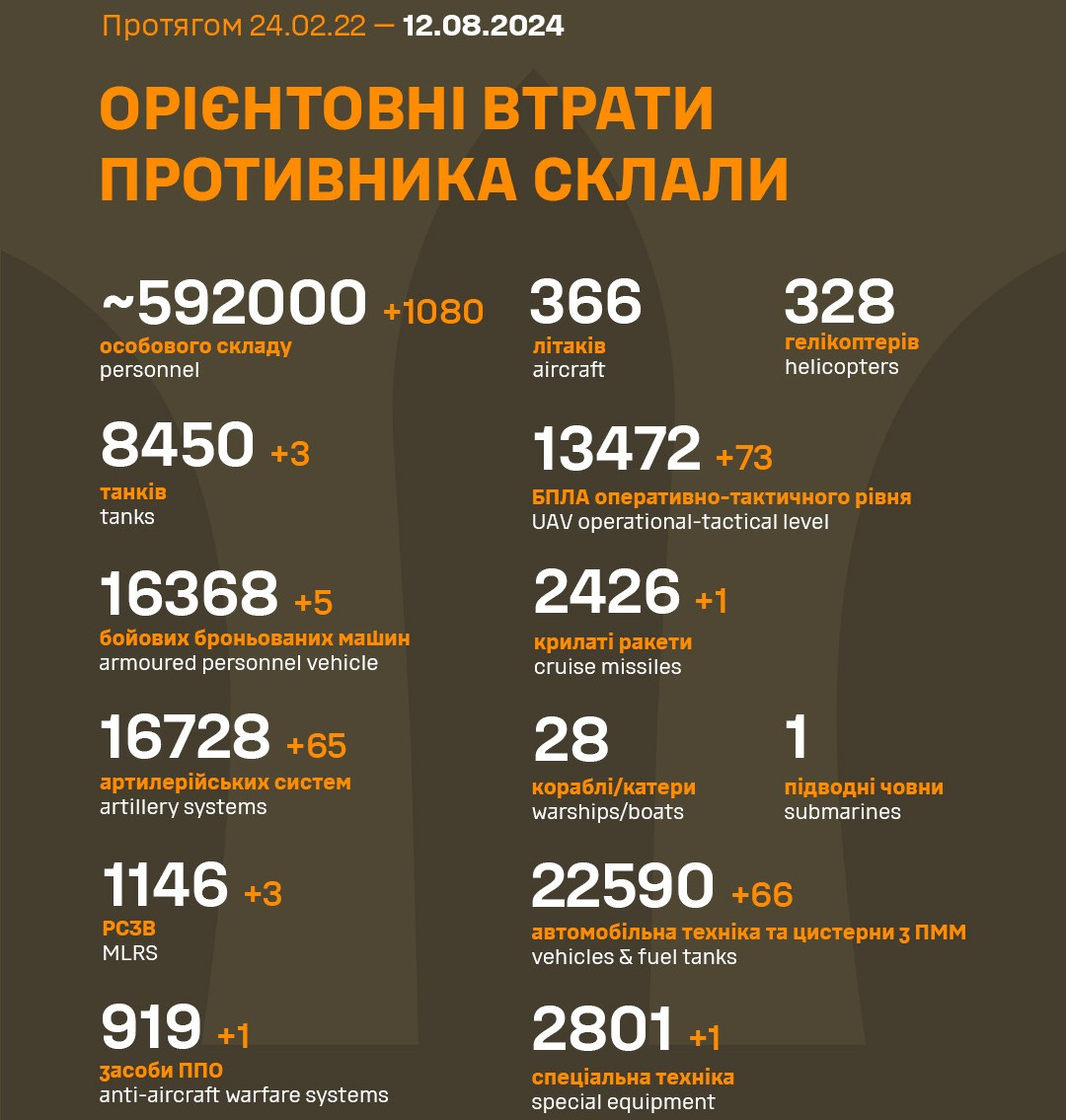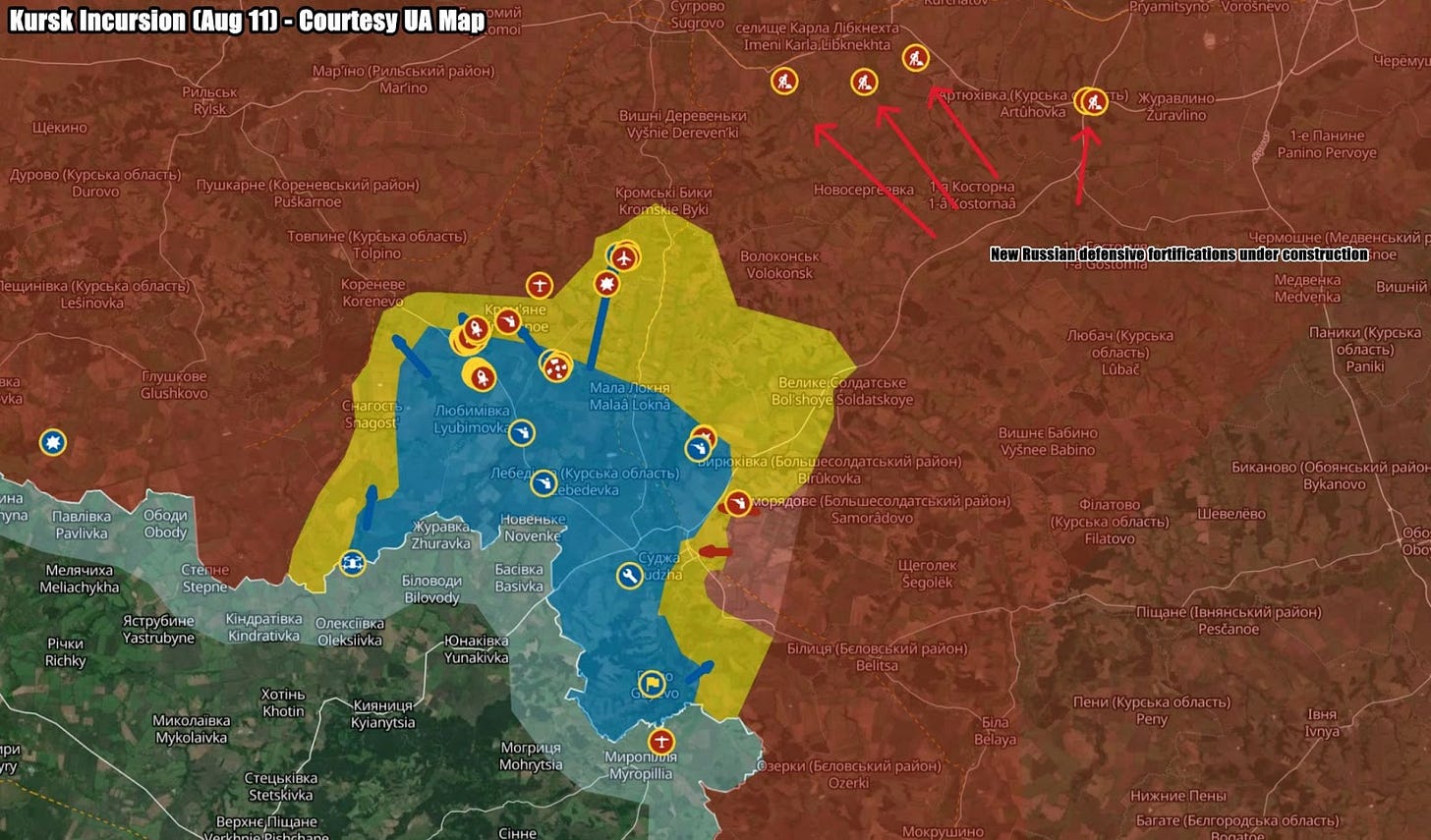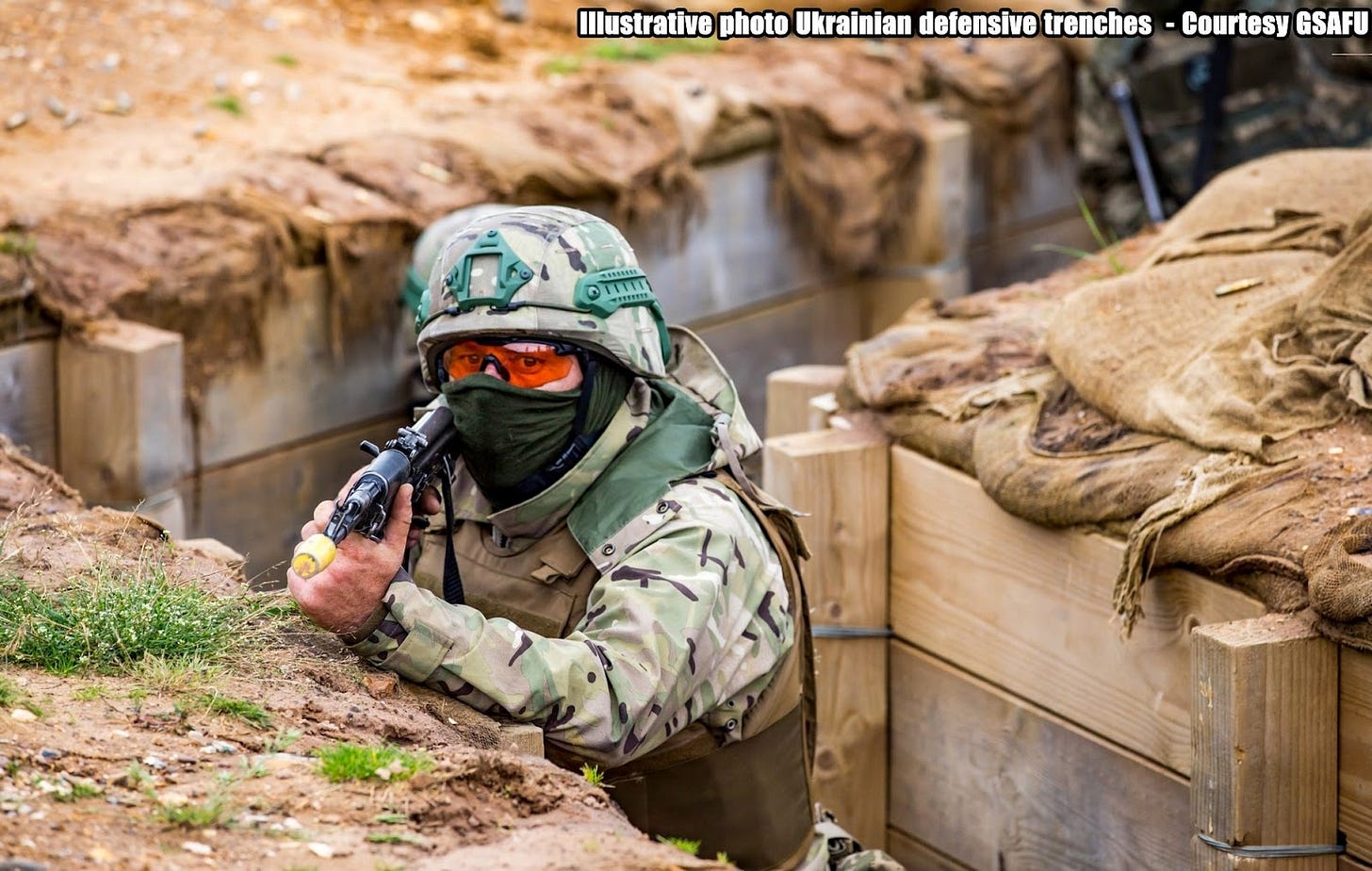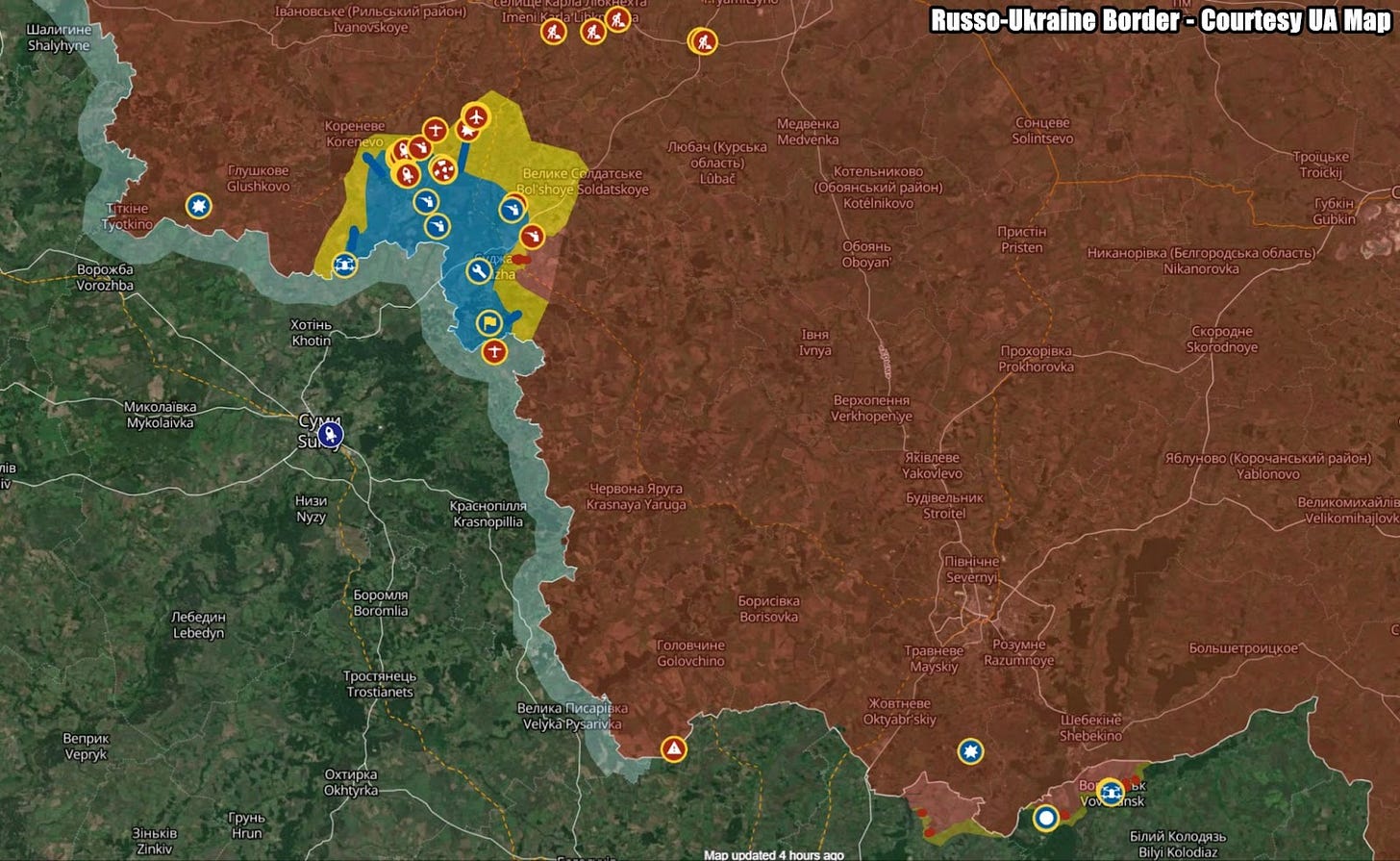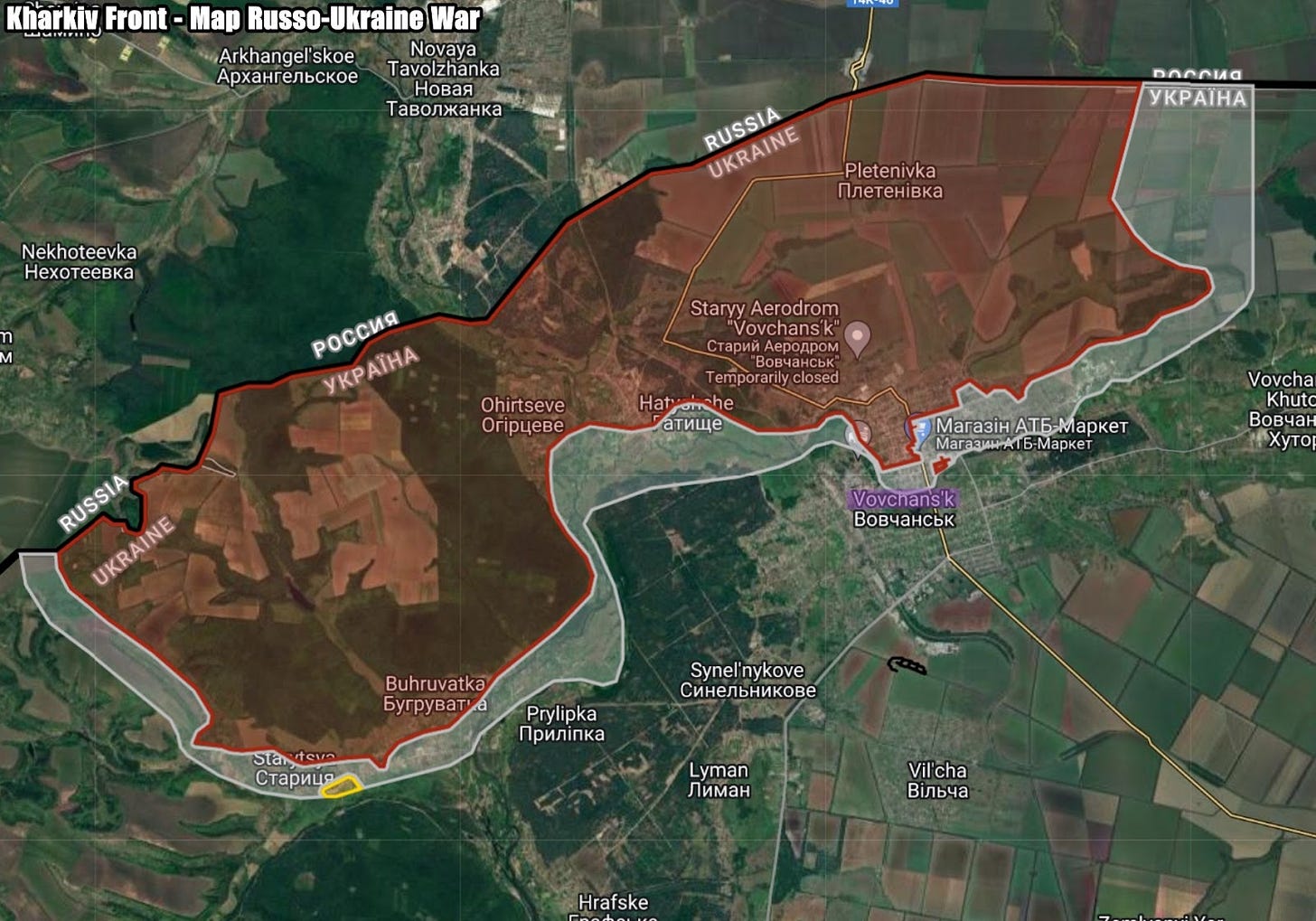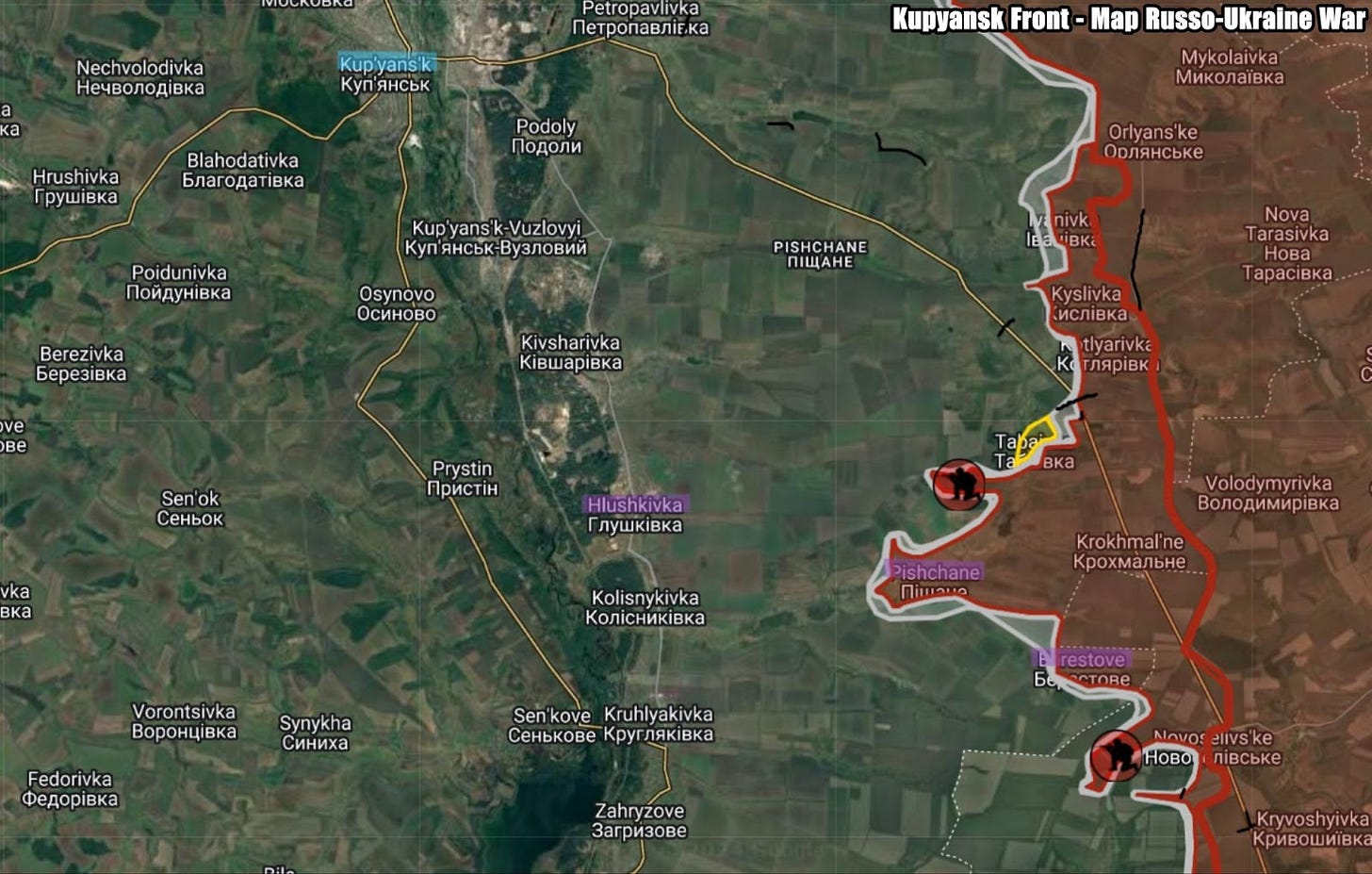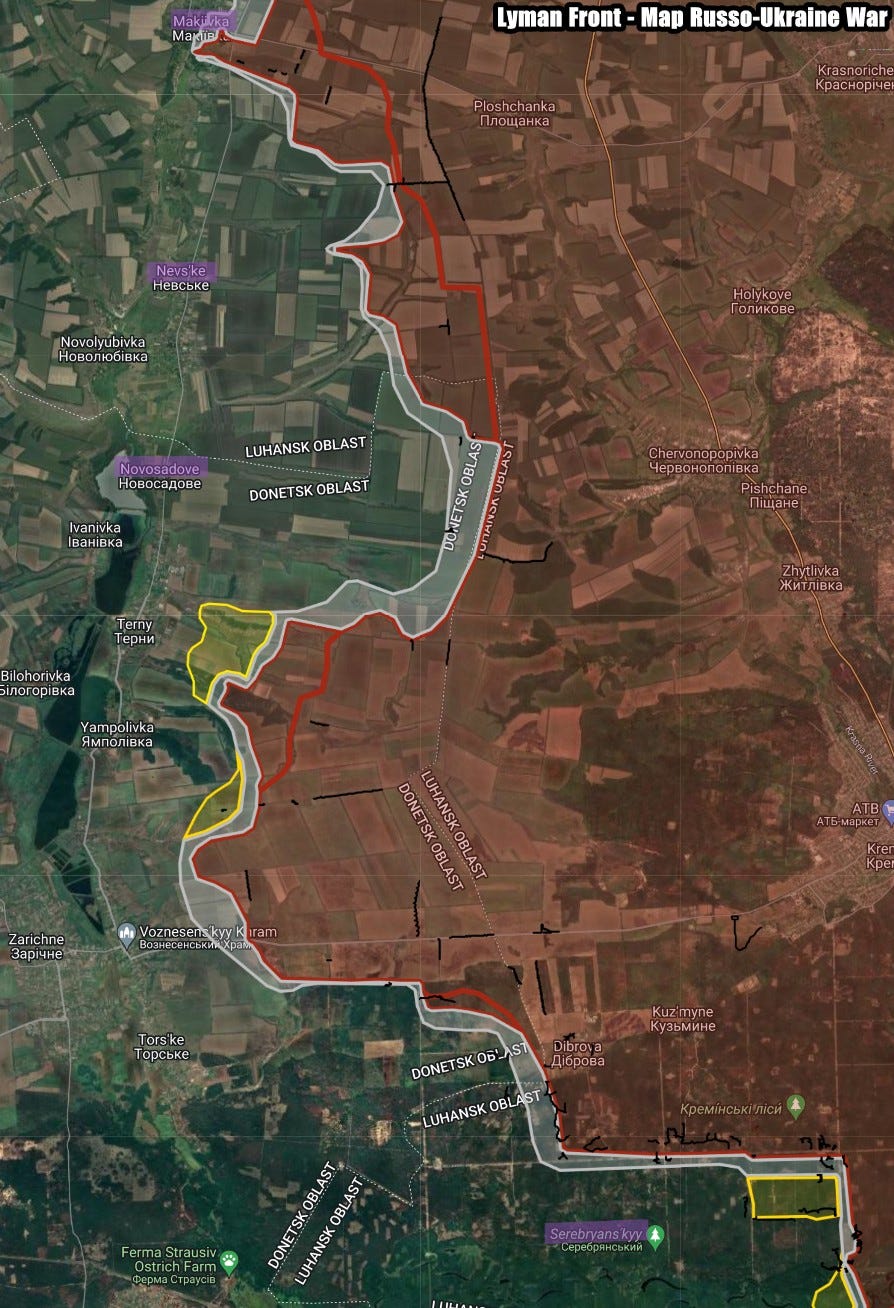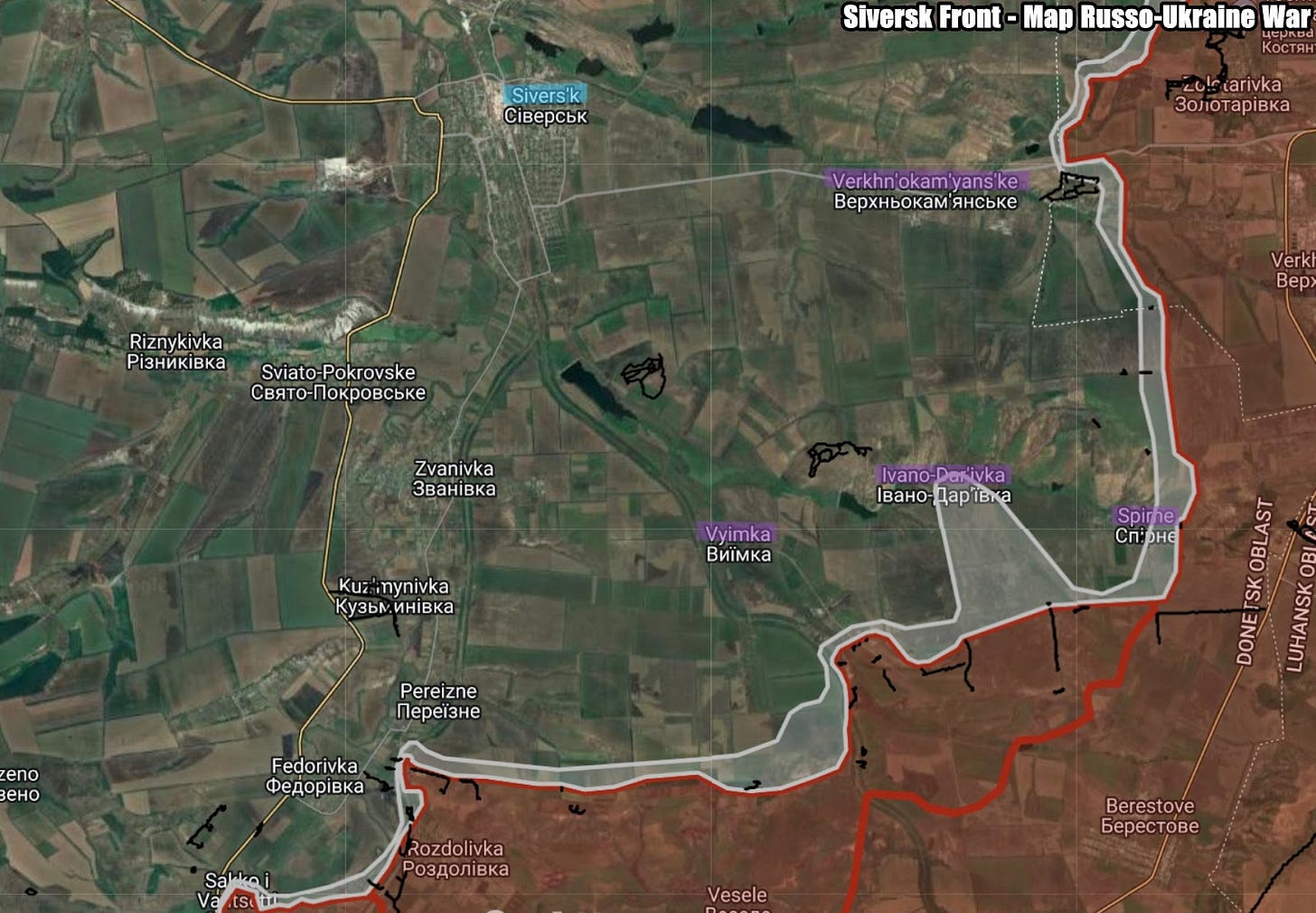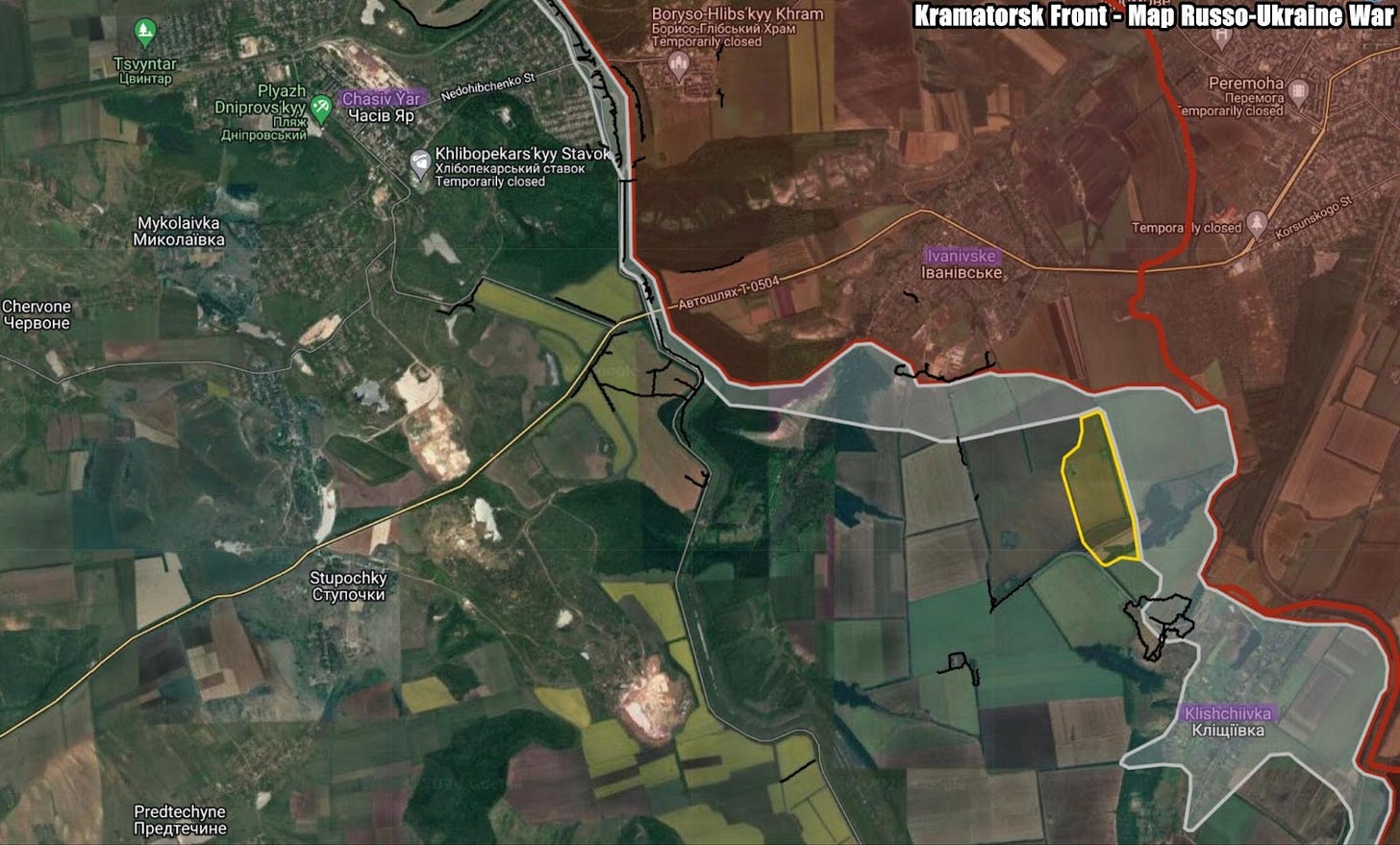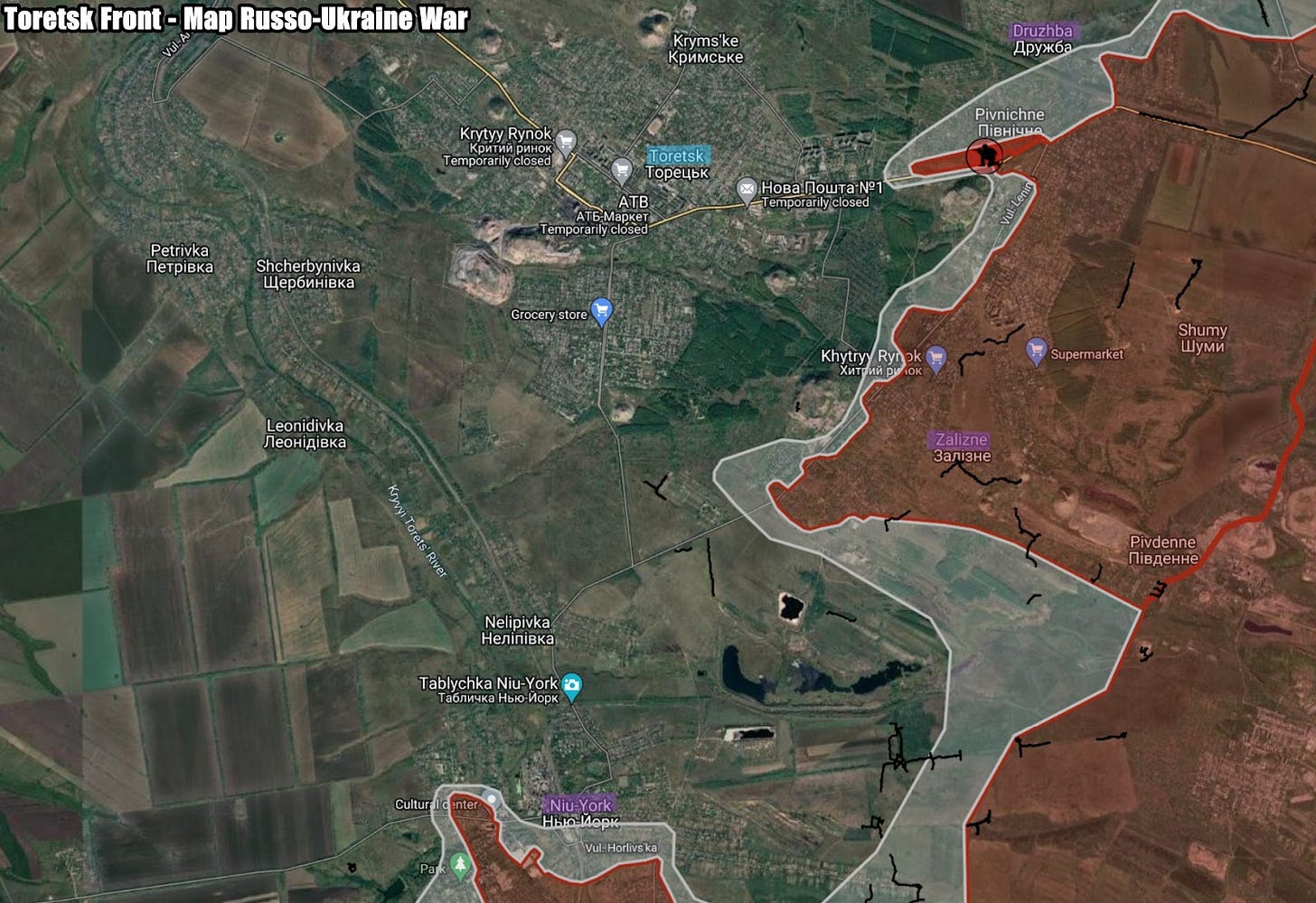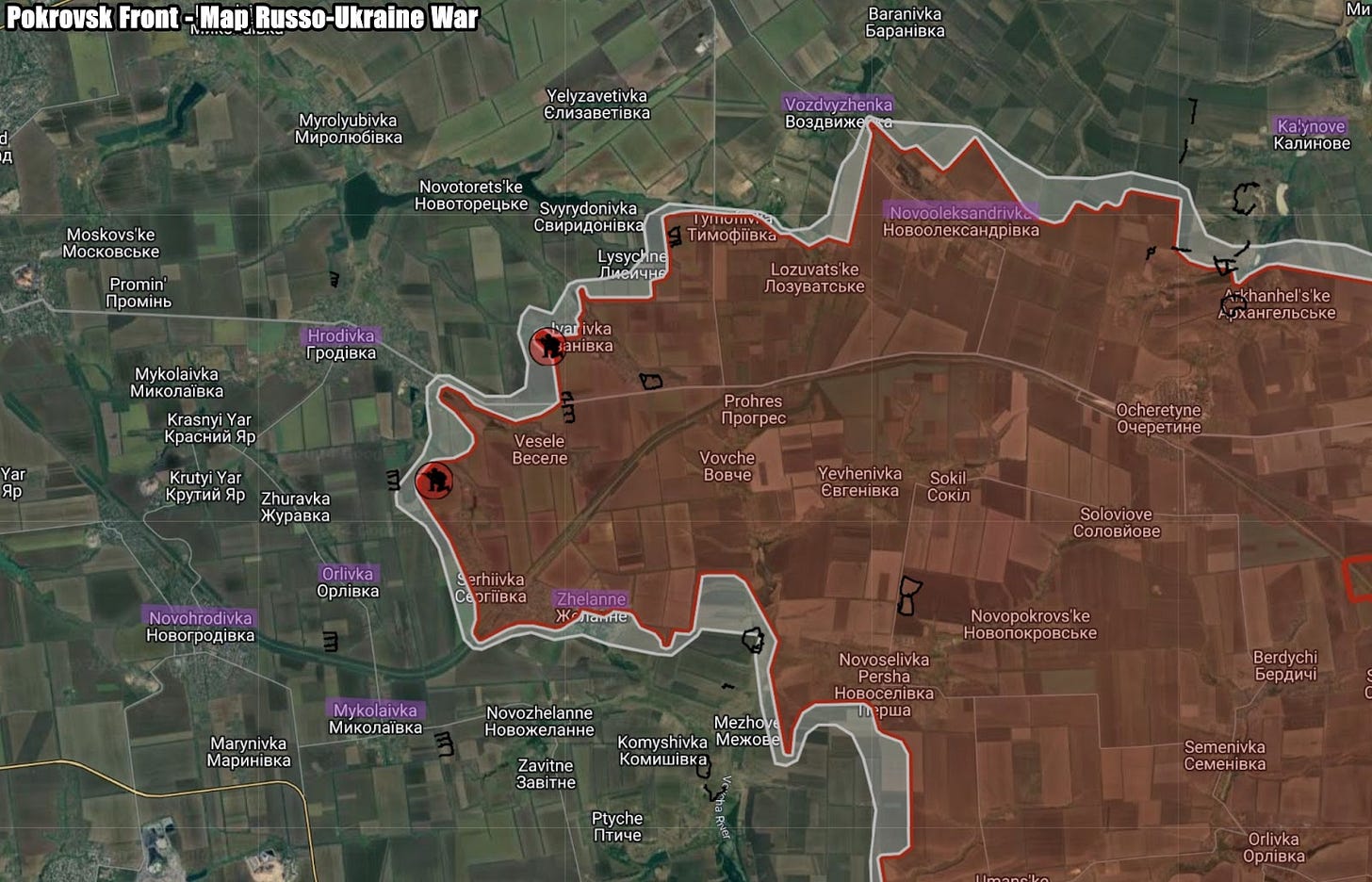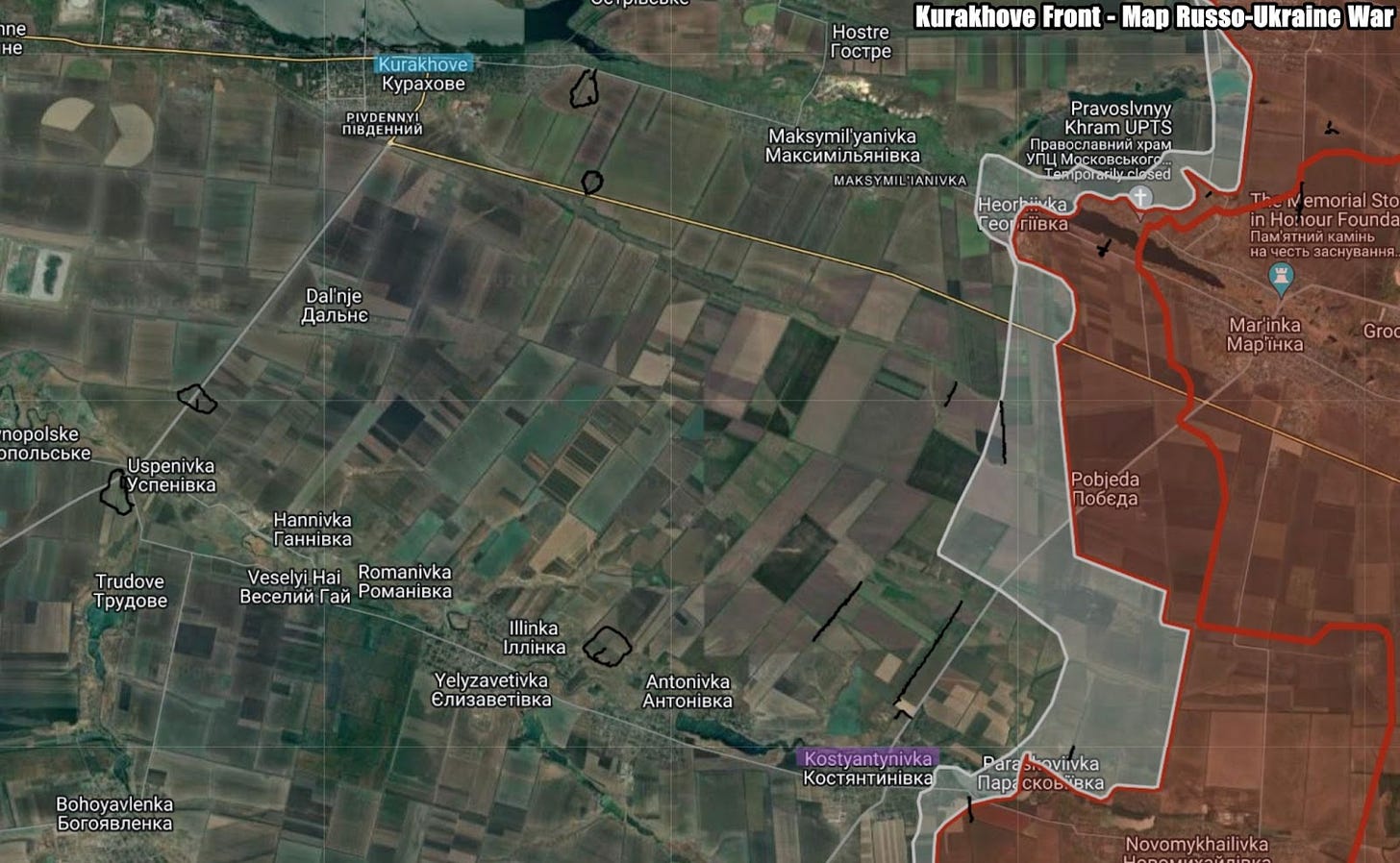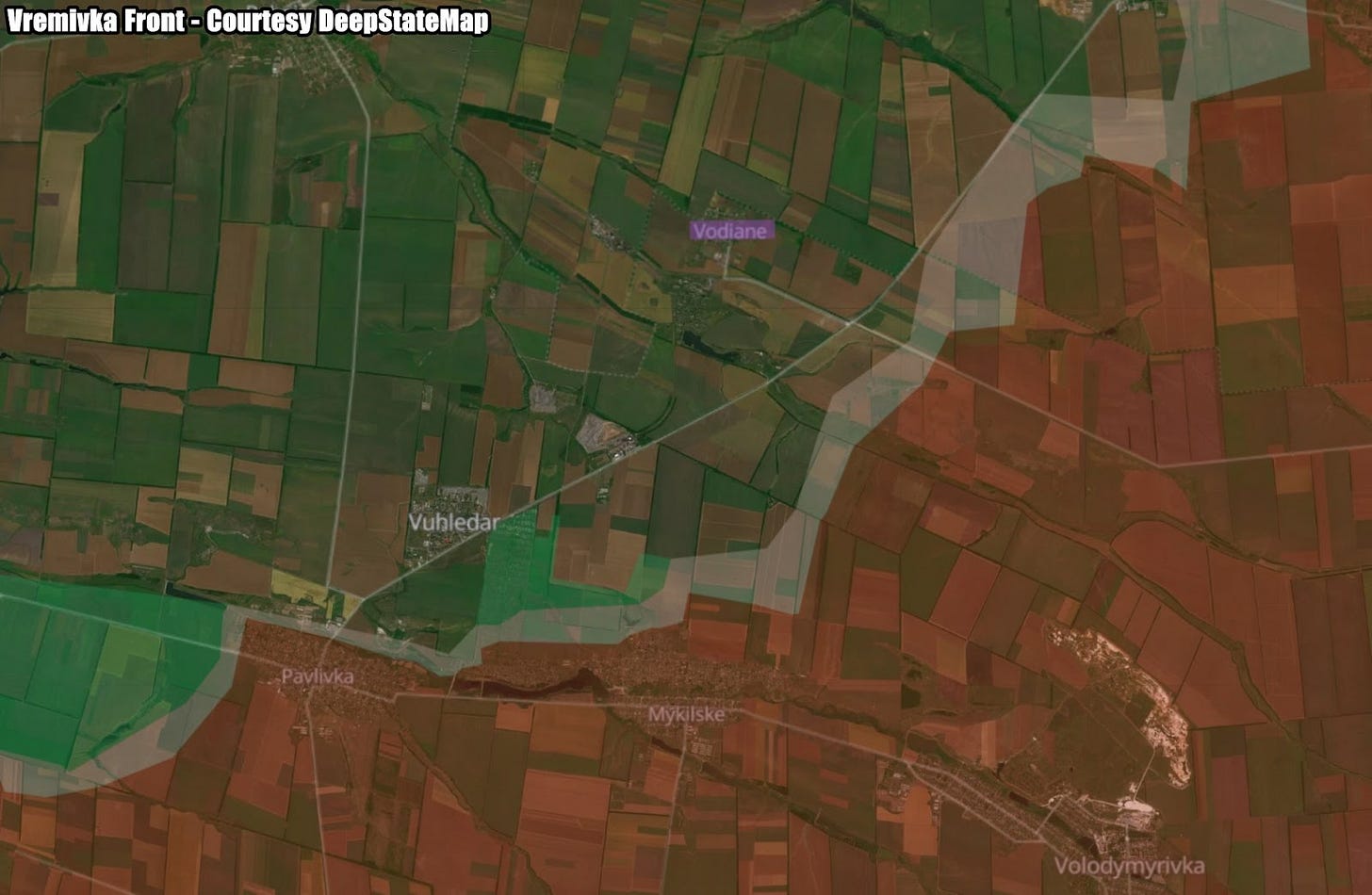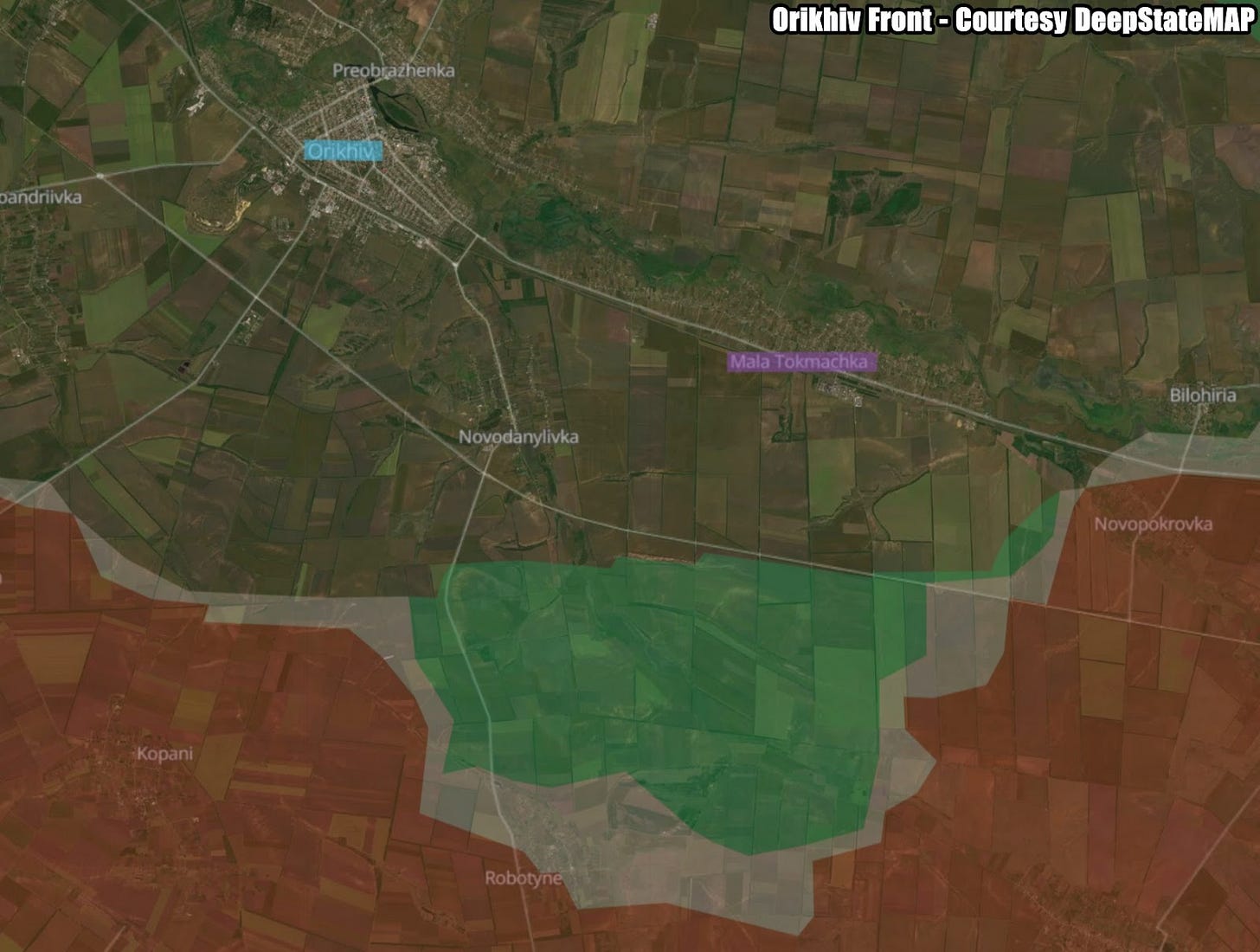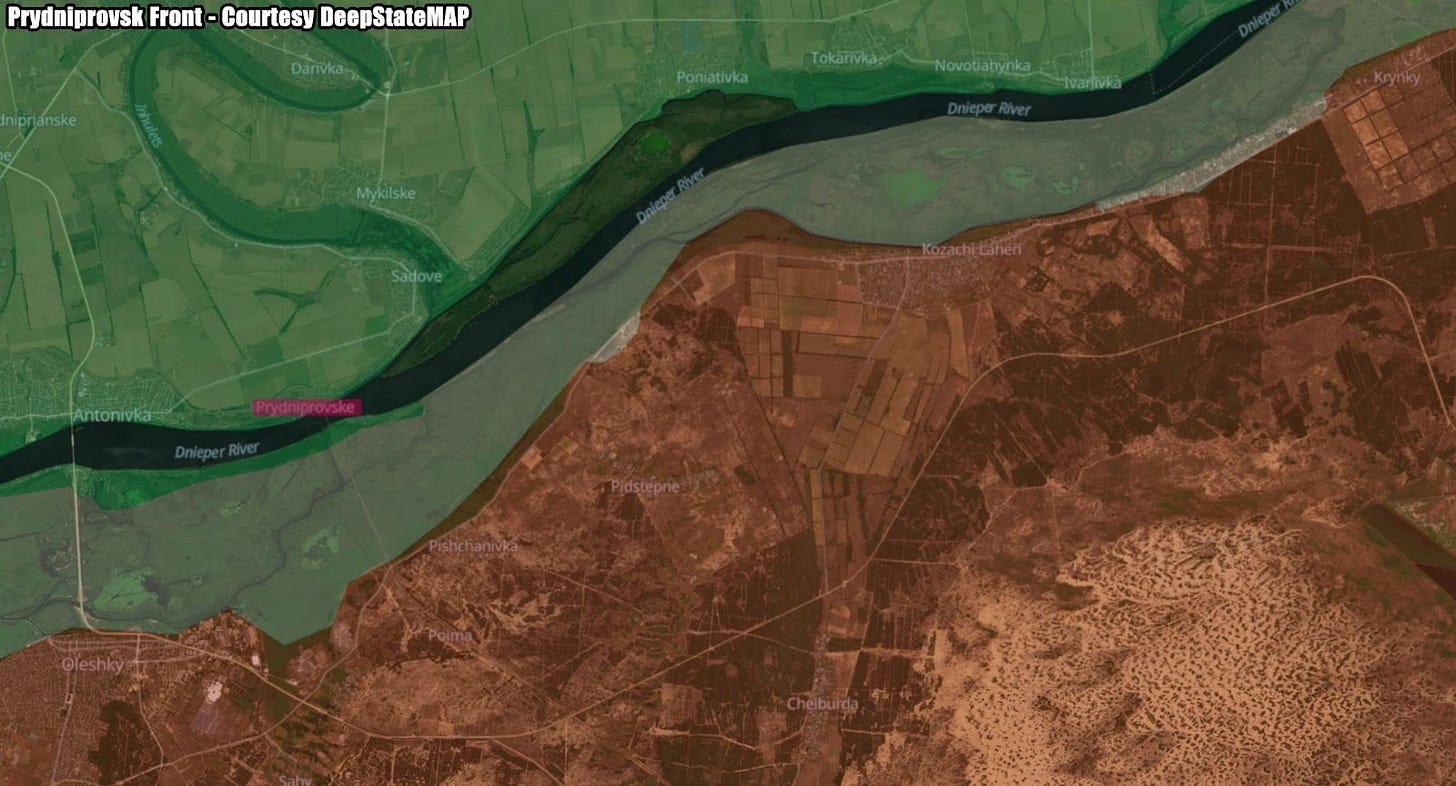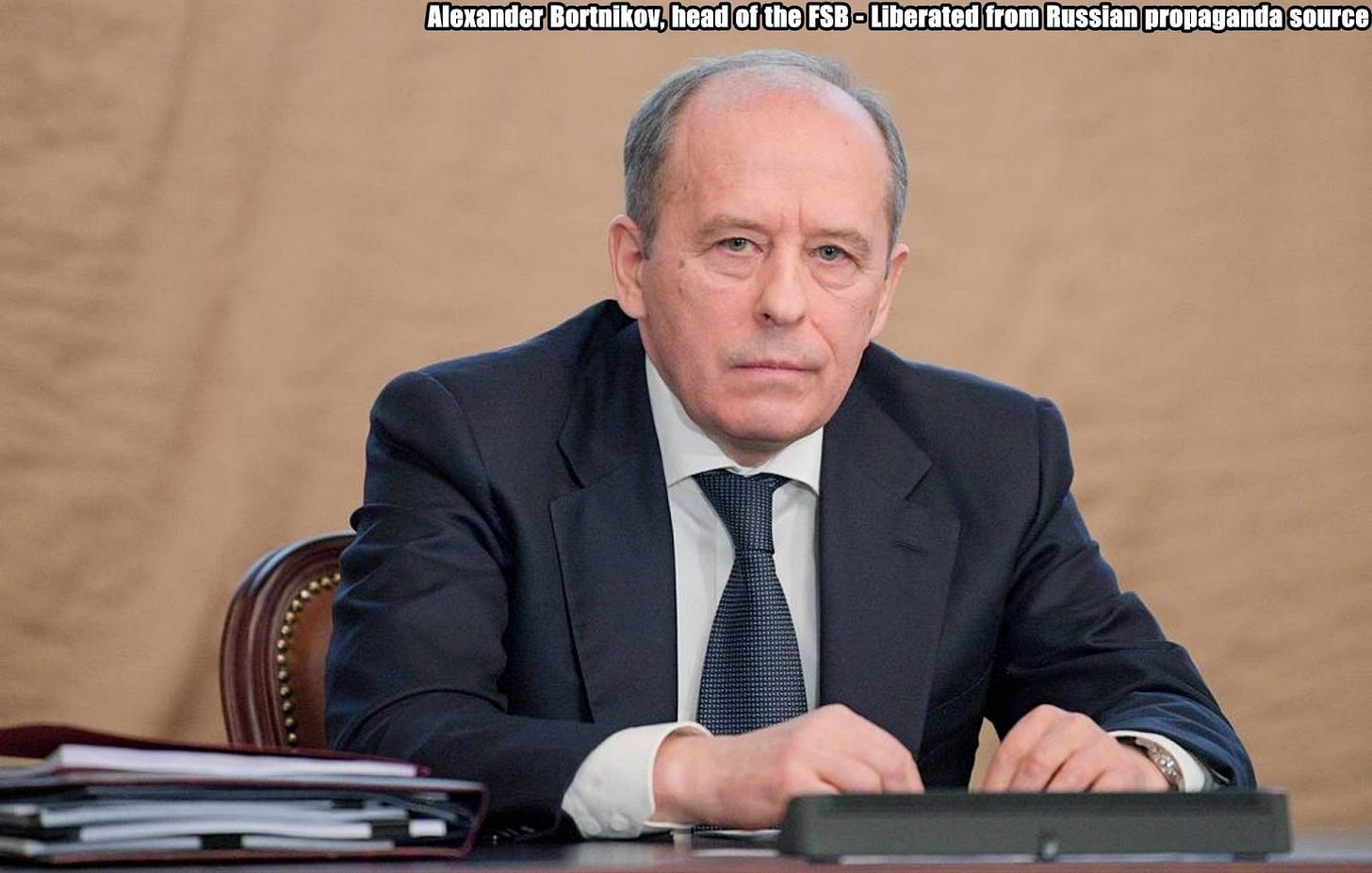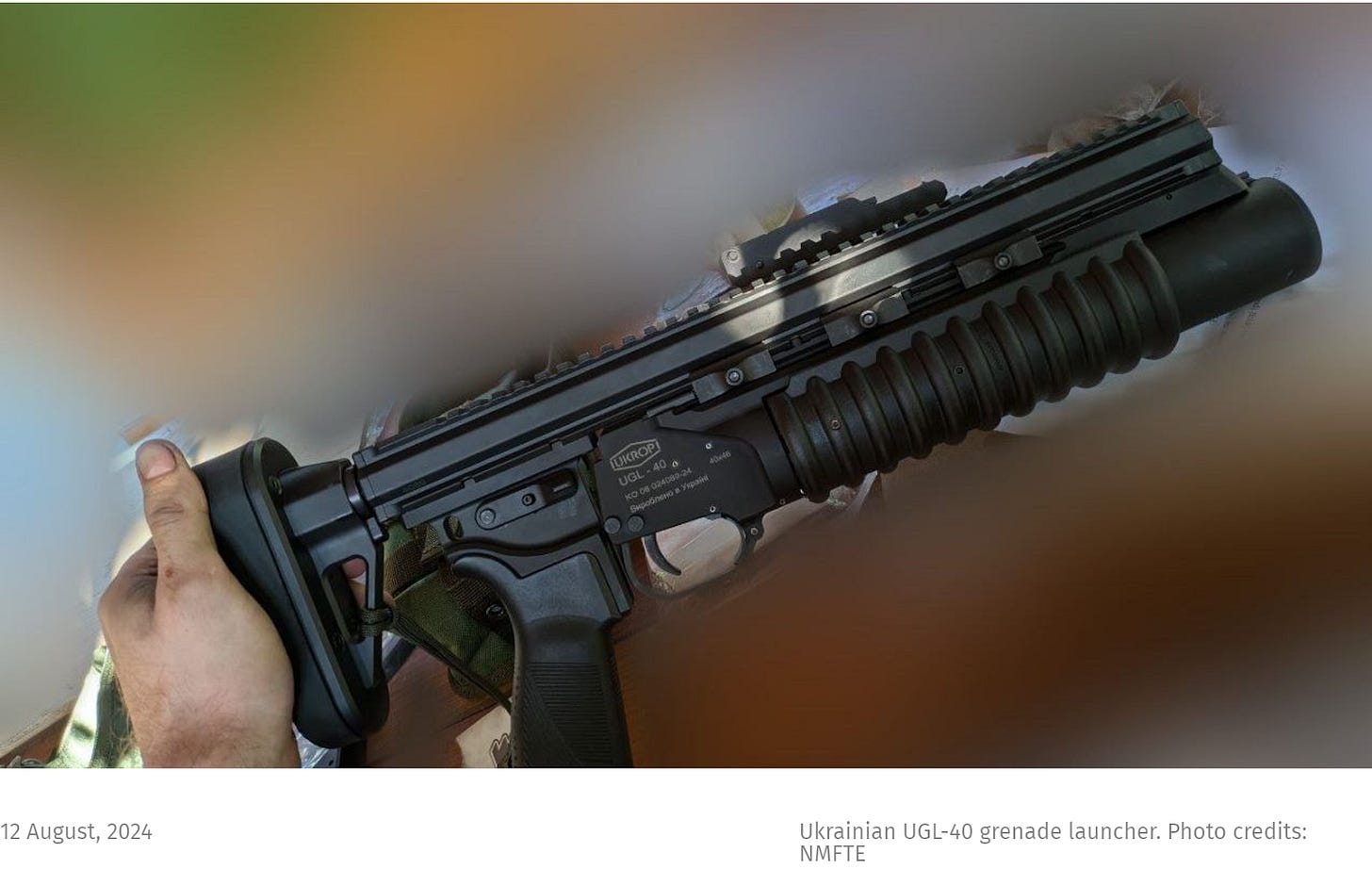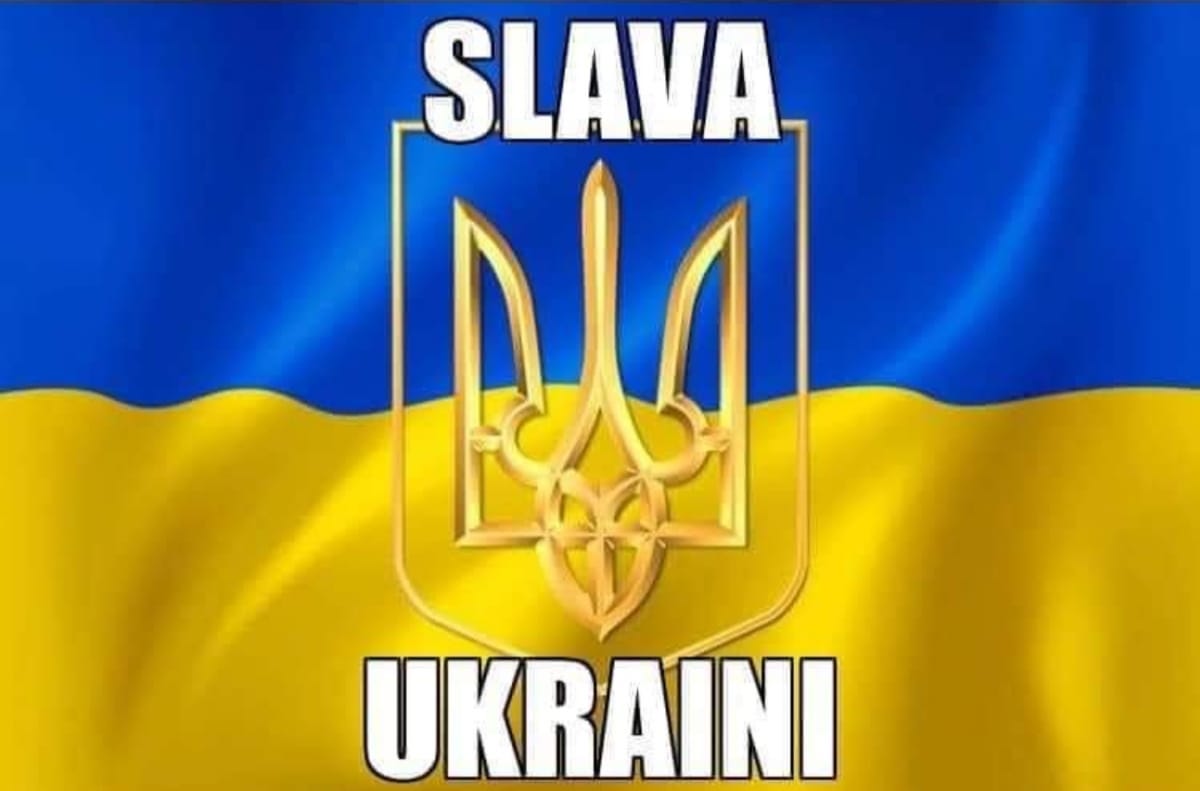Slava Ukraini! In early 2022 I began a Telegram channel aggregating news from a number of sources daily on the war in Ukraine. Since June 2023 I have provided a daily draft for the Ukraine War Brief Podcast collecting news from over 70 sources daily, much of which forms the basis of the script. While the Podcast is on hiatus I will make this Draft available here both on my own Substack and The People’s Media for those who wish to keep up with events on a daily basis.
ALONG THE CONTACT LINE
GSAFU Morning Report
The General Staff of the Armed Forces of Ukraine in its Operational Information update at 22:00 on Aug 11 stated that day 900 of the full-scale invasion of the Russian Federation against Ukraine was about to begin.
During the past day, 71 combat engagements took place. Over the past 24 hours, the enemy carried out 4 missile strikes, 45 air strikes,229 drone strikes and almost 2,300 artillery strikes across the positions of Ukrainian forces.
At the same time, Ukrainian soldiers continue to inflict losses in manpower and equipment on the occupying troops, exhausting the enemy along the entire front line and continue to disrupt the plans of Russian occupiers to advance deep into the territory of Ukraine.
The Russian Border Incursion
ISW - Ukraine seizes battlefield initiative.
The Institute for the Study of War (ISW), a US based think tank, in its Aug 11 Russian Offensive Campaign Assessment assessed that Ukraine's operation in Kursk Oblast has allowed Ukrainian forces to at least temporarily seize the battlefield initiative in one area of the frontline and contest Russia's theatre-wide initiative.
The Ukrainian operation in Kursk Oblast and further possible Ukrainian cross-border incursions force a decision point on the Kremlin and the Russian military command about whether to view the thousand-kilometre-long international border with northeastern Ukraine as a legitimate frontline that Russia must defend instead of a dormant area of the theatre as they have treated it since Fall 2022. Moscow’s response may require the Russian military command to consider the manpower and materiel requirements for defending the international border as part of its theatre-wide campaign design and can therefore impose long-term operational planning constraints that Russia previously did not face.
The Russian military command has essentially treated the international border with northeastern Ukraine as the dormant front of the theatre following the Russian withdrawal from Kyiv, Chernihiv, and Sumy oblasts in Spring 2022 and the Ukrainian liberation of significant territory in Kharkiv Oblast in Fall 2022. Russian and Ukrainian forces have conducted routine sabotage and reconnaissance activities, indirect fire, and cross-border strikes along the border since Fall 2022, but none of this routine activity has appeared to generate wider Russian operational concerns for defending Russian territory in the area. Russia has sought to use the threat of cross-border incursions to draw and fix Ukrainian forces along the border by concentrating rear elements in the border zone, but Ukrainian concentrations in the area do not appear to have generated such responses among Russian forces.
The Russian military activated part of this "dormant frontline" when it launched the offensive operation into northern Kharkiv Oblast in early May 2024 — a Russian effort to extend the frontline further into northeastern Ukraine to draw and fix Ukrainian forces along the border in hopes of weakening the overall Ukrainian frontline in aggregate.
Geolocated footage and Russian and Ukrainian reporting from August 10 and 11 indicate that Ukrainian forces advanced westward and northwestward in Kursk Oblast, although Russian sources largely claimed that Russian forces have stabilised the situation.
Geolocated footage published on August 11 indicates that Ukrainian forces were recently operating southeast of Korenevo. Additional geolocated footage published on August 11 indicates that Ukrainian forces recently advanced near Kremyanoye (east of Korenevo). Geolocated footage published on August 11 indicates that Ukrainian forces recently advanced in southern Cherkasskoye Porechnoye (north of Sudzha). Further geolocated footage published on August 11 indicates that Ukrainian forces were recently operating west of Malaya Loknya (northwest of Sudzha).Geolocated footage published on August 10 and 11 indicates that Ukrainian forces were recently operating near Zaoleshenka, southeast of Goncharovka, and southwest of Gogolevka (southwest of Sudzha). Additional geolocated footage published on August 11 indicates that Ukrainian forces were recently operating within Guevo (south of Sudzha).
The hastily assembled and disparate Russian force grouping responding to the Ukrainian incursion into Kursk Oblast is composed of Russian units likely below their doctrinal end strength and ill-prepared to establish the joint command and control (C2) structures necessary to coordinate operations.
Ukrainian military observer Kostyantyn Mashovets reported on August 11 that Russian forces have thus far redeployed roughly 10 to 11 battalions from across the theatre to Kursk Oblast but suggested that these battalion units are below their intended end strength, likely further exacerbating the disorganisation of the Russian response.
Russia’s redeployment of battalion and lower-level units rather than full brigades and regiments to defend in Kursk Oblast is likely contributing to Russian forces' difficulty in quickly establishing effective C2 in the area.
Confusion about the status of Russian conscripts fighting in Kursk Oblast is a consequence of ineffective C2 and will likely continue to further strain Russia’s C2 structures to respond to the Kursk operation
Russian officials acknowledged that Ukrainian mobile groups advanced upwards of 25 kilometres into Belovsky Raion, Kursk Oblast on the night of August 10 to 11, but there are no indications that these groups remain in the area or that Ukrainian forces are operating beyond the immediate border area in Belovsky Raion.
The reported rapid Ukrainian manoeuvre in Belovsky Raion suggests that Russian forces along the international border remain poorly prepared to respond to further Ukrainian cross-border incursions.
Ukraine in control of 28 settlements in Kursk Oblast, Russian official says
Ukraine is in control of 28 settlements in Kursk Oblast, one week after launching a surprise attack into Russian territory, regional authorities said on Aug. 12. The Kyiv Independent reports.
Speaking at a meeting to discuss the ongoing situation in the region, Alexey Smirnov, the acting governor of Kursk Oblast, described it as "difficult."
"Today, 28 settlements are under enemy control," he added, in comments reported by Russian state media.
The Ukrainian military launched a surprise incursion across the border into Kursk Oblast on Aug. 6, bringing regular Ukrainian forces into Russia for the first time.
Smirnov's statement is the first official comment from either side on the status of territorial control in the region.
While Ukrainian officials and military command have so far not officially commented on the operation in Kursk Oblast, media have been forced to rely on limited and questionable information circulated by Russian Telegram channels and videos of Ukrainian forces that often surface anonymously.
In these conditions, it has so far remained unclear not only what territory Ukrainian forces hold, but whether they plan to dig in and fortify a new front line inside Russia, or eventually return across the border.
Although reinforcements sent by Moscow have begun to arrive on the battlefield, Ukraine has reportedly continued to advance farther into Kursk Oblast.
Russian authorities have been forced to announce widening civilian evacuation measures in a number of districts bordering Ukraine.
Earlier on Aug. 12, Smirnov said those living in the Belovsky district located on the border with Ukraine were being advised to leave.
Grumpy here - As a side note you may wonder why there is an “acting governor” of Kursk Oblast. A lot of people would like to know the answer to that. The Governor may have fled, he may be in hiding, he may have been yeeted out a convenient window, or he may have been snatched by Ukrainian SF at the beginning of the incursion. Inquiring minds want to know.
Ukrainian Troops Are Digging Trenches In Russia’s Kursk Oblast. It’s A Sign They Plan To Stay.
On the sixth day of Ukraine’s advance into Kursk Oblast in southern Russia, there’s growing evidence the Ukrainian invasion corps—some or all of up to five 2,000-person brigades plus at least one 400-person independent battalion—plans to stay. David Axe of Forbes wrote on Aug 11.
The Ukrainians are digging trenches. Anticipating static warfare along or near the existing front line, the Russians are digging in, too.
That both sides are fortifying their positions doesn’t mean the Ukrainians are done advancing. Nor does it mean the Russians can’t counterattack—and push the Ukrainians back to the border, 10 miles away.
But it does mean that stabilisation of the front line—and a long-term Ukrainian occupation of part of Kursk—is on the table.
Ukrainian sources have spotted industrial excavators at work on both sides of the front line.
The Ukrainians have already positioned potentially more than 10,000 troops in Kursk and the adjacent Ukrainian oblast, Sumy. And according to the Ukrainian Center for Defense Strategies, Russia’s Northern Grouping of Forces is trying to move 10 to 11 battalions to the front line—perhaps 4,000 troops in all.
Those 10 or so Russian battalions are just the initial echelon, however. On paper, the Northern Grouping of Forces oversees 48,000 troops. Many of them are bogged down in Vovchansk, the locus of Russia’s own attack across the Russia-Ukraine border that kicked off in May.
But if it gives up trying to advance in Vovchansk and other front-line towns and cities, the Russian military could shift significant forces to Kursk. Indeed, compelling the Russians to deplete their forces along other fronts may have been the Ukrainian invasion corps’ main objective.
Kyiv is probably trying to “divert some of the Russian attention and Russian troops stationed in the eastern parts of Ukraine,” France 24’s Emmanuelle Chaze noted, citing Ukrainian sources.
Once the trenches are complete, that diversion could become long-term—if not permanent.
The Khortytsia operational-strategic group
(Responsible for the northeastern part of Ukraine. )
Kharkiv axis: There were 3 Russian attacks over the last day near Vovchansk. 2 were repelled, 1 is ongoing.
Kupyansk axis: The enemy carried out 4 attacks against Ukrainian positions near Hlushkivka, Pishchane and Berestone. 1 engagement is still ongoing.
Lyman axis: Russia attacked 12 times unsuccessfully in the direction of settlements of, Makiivka, Nevske, Novosadove and the Serebryanskyy Forest. 3 attacks continue.
Siversk axis: Russian forces carried out 6 assaults in the vicinity of Verkhnokamianske, Ivano-Darivka, Spirne and Vyimka. 3 are ongoing.
Kramatorsk axis: Russian forces carried out 6 offensive actions near Chasiv Yar, Ivanivske and Klischiivka 1 attack continues. The situation is under control.
Toretsk axis: There have been 4 Russian attacks over that last day with air support. All the efforts of the enemy were directed to the areas of Druzhba, Zalizne and Nui-York. 2 attacks are still ongoing.
The Tavria operational-strategic group
(Responsible for the central-eastern and southeastern part of Ukraine.)
Pokrovsk axis: The greatest activity of the enemy today occurred in the Pokrovsk sector. The enemy conducted 39 attacks against Ukrainian defences in this area over the last day concentrating in the vicinity of Kalynove, Vozdvizhenka, Novooleksandrivka, Hrodivka, Orlivka, Novohrodivka, Zhelanne and Mykolaivka. 9 battles continue
Kurakhove axis: Russian forces unsuccessfully tried to advance 2 times in the area of settlement of Kostiantinivka. 1 battle is ongoing.
Vremivka axis: In this sector the situation is under control, Russian forces made 1 Russian assault against Ukrainian positions near Vodiane is ongoing.
Orikhiv axis: The situation in this sector has not changed significantly. 2 enemy attack was repulsed over the last day in the vicinity of Mala Tokmachka
The Odesa operational-strategic group
(Responsible for Kherson, Qırım, (also known as Crimea) and the Black Sea.)
Prydniprovsk axis: In this sector, over the last day, the situation has not changed significantly. Russian forces made 2 unsuccessful attempts to force Ukrainian units from their positions on the left bank of the Dnieper.
TEMPORARILY OCCUPIED TERRITORIES
Fire at Zaporizhzhia nuclear plant has been extinguished
The fire at the Zaporizhzhia Nuclear Power Plant, reportedly started by Russian shelling the day before, has been extinguished, Dnipropetrovsk Oblast Governor Serhii Lysak said on Aug. 12. The Kyiv Independent reports.
The previous day, Yevhen Yevtushenko, the head of the military administration in Nikopol, said that Russian forces had fired on the cooling towers of the plant, causing a blaze to break out.
"Perhaps this is a provocation or an attempt to create panic in the settlements on the right bank of the former reservoir," Yevtushenko said at the time.
In a Telegram message at 7:30 a.m. local time, Lysak said the fire at the plant had been put out and that radiation levels in the area were normal.
President Volodymyr Zelensky called on the International Atomic Energy Agency (IAEA) to hold Russia accountable for the provocation.
"As long as Russian terrorists retain control of the nuclear power plant, the situation is not and cannot be normal," Zelensky said in a Telegram post on Aug. 11. "We are waiting for the world's reaction, waiting for the IAEA's reaction."
THE HOME FRONT
Ukraine's deputy energy minister arrested on corruption charges, SBU says
Ukraine's deputy energy minister Oleksandr Kheilo was arrested on corruption charges, the Security Service of Ukraine (SBU) reported on Aug. 12. The Kyiv Independent reports.
While the SBU said only that a deputy energy minister had been arrested and did not mention Kheilo by name, Ukrainska Pravda soon confirmed that he was the individual in question.
The official portal of Ukraine's Cabinet of Ministers later reported that Kheilo had been dismissed from his position.
According to the SBU, Kheilo allegedly demanded bribes from representatives of a state-owned coal company to facilitate the transfer of mining equipment from near the frontline hotspot of Pokrovsk in Donetsk Oblast, where fighting is currently ongoing, and then transport it to the Lviv-Volyn region in western Ukraine.
Kheilo allegedly involved three other accomplices in his corruption scheme—an independent energy trader, the head of an energy company in Mykolaiv Oblast, and the head of a mining company in Donetsk Oblast.
The SBU documented several tranches of bribe payments, and the individuals in question were reportedly caught "red-handed."
The four conspirators have been charged with receiving a bribe and face up to 12 years in prison if convicted.
In a post on its official website, the Energy Ministry said it was cooperating with law enforcement authorities to "ensure an objective investigation and establish all the circumstances of the offence."
RUSSIAN WORLD
Putin removed Gerasimov from the leadership of the Kursk Theatre of Operations
Alexander Bortnikov, head of the FSB is again in the spotlight due to the situation in the Kursk region. Goloskarpat reports.
According to data Institute the study of the war (ISW), the head of the FSB of the Russian Federation, Alexander Bortnikov, demonstrated his effectiveness in crisis situations, which helped to prevent a coup d'etat and stop the procession of Yevgeny Prigozhin to Moscow last summer. This success provided Bortnikov with personal praise from President Vladimir Putin.
Now Bortnikov has received a new appointment – to lead the “counter-terrorist operation” in the Kursk region. Probably, such a decision is connected with his reputation as a crisis manager, which was confirmed in previous situations that threatened the stability of the Kremlin.
At the same time, analysts believe that the appointment of Bortnikov may indicate Putin’s dissatisfaction with the situation with the offensive of the Armed Forces of Ukraine (VSU) in the territory of the Russian Federation. Recent events indicate that the previous chief of the General Staff of the Armed Forces of the Russian Federation Valery Gerasimov did not inform Putin about the real situation, which led to unforeseen consequences.
Bloomberg reports that Russian intelligence knew about the plans of the Armed Forces two weeks before the breakthrough in the Kursk region, but Gerasimov ignored these warnings so as not to bother the president. As a result, the offensive of the Armed Forces was a complete surprise for the Kremlin, which was originally in a panic.
According to the Financial Times, the Ukrainian military was able to advance 30 km deep into Russia in six days of the offensive. The Kremlin is trying to slow down progress by deploying additional units, but to no avail.
Ukrainian officials told AFP that “ thousands” of people are currently involved. At the same time, the situation at the front, where Russian occupiers continue to move slowly in the east, remains under control, and the details of the operation are not yet disclosed.
- -
MSN reported citing The Institute for the Study of War (ISW), a US based think tank, According to ISW, Russian dictator Vladimir Putin appointed FSB Chief Alexander Bortnikov as the commander of the "anti-terrorist operation" following the Ukrainian army's entry into the Kursk region.
"Putin likely appointed Bortnikov as the head of the counterterrorist operation because Bortnikov had previously proven himself to be an effective manager during crises that threatened Russian domestic stability and the Kremlin regime," reads the ISW report.
Analysts note that Bortnikov was involved in negotiations and provided guarantees to Yevgeny Prigozhin, the founder of the Wagner Group, during last summer's uprising. After re-election, Putin publicly praised the FSB director for "ensuring Russia's security and sovereignty."
ISW explains that appointing Bortnikov as the commander of the anti-terrorist operation indicates that "Putin was dissatisfied with how the Russian military command handled the situation in the Kursk region."
NEWS WORLDWIDE
Billions in dollar and euro notes reach Russia despite sanctions
Around $2.3 billion in dollar and euro bills have been shipped to Russia since the United States and EU banned the export of their banknotes there in March 2022 following the invasion of Ukraine, Reuters reported citing customs data.
The customs data, obtained from a commercial supplier that records and compiles the information, shows cash was transported to Russia from countries including the UAE and Turkey, which have not imposed restrictions on trade with Russia. The country of origin for more than half the total was not stated in the records.
The U.S. government in December threatened penalties for financial institutions that help Russia circumvent sanctions and has imposed sanctions on companies from third countries throughout 2023 and 2024.
China's yuan has overtaken the greenback to become the most traded foreign currency in Moscow, although significant payment problems persist.
Dmitry Polevoy, head of investment at Astra Asset Management in Russia, said many Russians still wanted foreign currency in cash for trips abroad, as well as small imports and domestic savings.
"For individuals, the dollar is still a reliable currency," he told Reuters.
Russia's central bank and the United States' sanctions authority, the Office of Foreign Assets Control (OFAC), did not respond to requests for comment.
Ukraine can use German provided weapons at its discretion
Weapons provided by Germany to Ukraine become the property of Ukraine from the moment of their transfer and Kyiv can use them as it deems necessary and correct. Ukrinform reports citing German Defense Ministry spokesperson Arne Collatz from a briefing on Aug 12.
For the German Defense Ministry, there is no question of the legality of actions in the Kursk region: international law provides for the possibility of conducting military operations on the territory of the aggressor country for the sake of protecting one's own state, Collatz said. Therefore, according to him, this does not provide for any special conditions for the use of weapons provided by the Bundeswehr.
"After the weapons from Germany were handed over to Ukraine, they already belong to Ukraine, they are Ukrainian weapons... There are no obstacles, so Ukraine is free to choose its options," the officer said, adding that Ukraine is obliged to comply with international law.
Collatz clarified that the use of long-range weapons is a different, political issue.
MILITARY & TECH
Ukrainian military received a batch of attack UAVs from the KOLO fund
Soldiers of the Ukrainian Defense Forces have received a batch of attack drones. Militarnyi reported on Aug 12.
The KOLO Charitable Foundation handed over the UAV and published the relevant photos on its Facebook page.
The foundation emphasised that this was the largest batch of valuable drones for the entire period of the charitable foundation’s work.
These attack UAVs are already in the hands of Ukrainian defenders. They also added that these UAVs would hunt for the most important targets far beyond the contact line.
“As you understood, the project is secret, so we can’t tell you anything. However, we can show it nicely,” the charitable foundation wrote.
As previously reported, the Ukrainian company Skyeton, which produces ACS-3 (Raybird-3) reconnaissance systems, has launched production in Slovakia.
The production of Raybird drones in Slovakia started in the spring of 2024, with the company renting a 1000 sq m facility. The company invested $3.5 million to launch the production.
The Slovak plant is capable of building 25 reconnaissance systems per year, and after the investment round is closed, the capacity will be quadrupled. Skyeton is currently attracting $15 million in investments for the expansion.
Due to martial law, Raybird systems cannot be exported abroad, and the final price is limited to a 25% markup. In addition, development costs cannot be included in the price. The plant in Slovakia is not subject to these restrictions and opens up more opportunities in the global market.
Ukraine launches production of UGL-40 grenade launchers
The military has been spotted using UGL-40 single-shot hand-held grenade launchers manufactured by the Ukrainian company Ukrop. The photo was published by the NMFTE Telegram channel. Miltarnyi reports.
The UGL-40 is based on the design of the American M203A1 under-barrel grenade launcher for M4 assault rifles and is mounted on a chassis with a stock for autonomous use without main weapons.
The grenade launcher is equipped with a shortened to 224 mm barrel with a breech-loading principle of loading. According to the markings, it uses standard NATO 40×46 mm ammunition.
This is the first known appearance of the UGL-40 in the public domain. Its development and production were not previously publicised, so detailed specifications remain unknown.
The similar M203A1 is capable of precision fire on single targets at a distance of up to 150 metres and up to 350 metres on group targets.
It can use a wide range of Western ammunition in this calibre. These include traditional fragmentation grenades as well as more exotic armour-piercing, high-explosive, stun, gas and buckshot ammunition.
The weight of the grenade launcher itself is 1.36 kilograms, but the weight of the chassis and telescopic stock should be taken into account.
The Ministry of Defense has developed new procedures for flying Western combat aircraft
The press service of the Ministry of Defense reported that the The Ministry of Defense of Ukraine has developed new procedures for flying tactical aircraft, including Western-made ones.
The ministry noted that the new procedures were based on NATO standards. In particular, the relevant order contains guidelines, explanations and interpretations developed by the State Aviation Administration of Ukraine. They should help to safely operate tactical aircraft of domestic and Western models.
A specially created working group in the Air Force of the Armed Forces of Ukraine is already implementing the new standards. The State Aviation Administration also plans to develop four more sets of such procedures for other types of aviation, including unmanned aerial vehicles.
“Our tactical aviation has new flight procedures in accordance with NATO standards, which will enhance the capabilities of the Armed Forces. We are moving forward and doing everything possible to ensure that the Armed Forces of Ukraine have an advantage on the battlefield,” said First Deputy Minister of Defense Lieutenant General Ivan Havryliuk.
The ministry reminded that the State Aviation Administration of Ukraine was an authorised body of the Ministry of Defense responsible for implementing state policy in the field of state aviation and protecting Ukraine’s sovereignty both in peacetime and in a special period.
That’s it for today’s Draft folks if you would like to keep up with events in Ukraine daily please consider subscribing, its free!
Feel free to share this update with your friends. Heroyam Slava!







